Heisman Trophy is No Guarantee For NFL Success
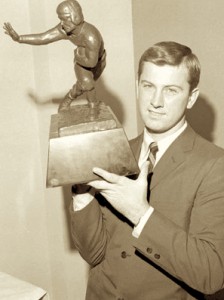
After winning the Heisman Trophy in 1966, Steve Spurrier spent a decade in the NFL primarily as a backup quarterback.
There are five talented college players being considered for the prestigious Heisman Trophy this week. However, if any of them truly want to have a long and successful NFL career they might want to hope that someone else’s name gets called on Saturday night.
Since the Heisman Trophy was first awarded in 1935, it has gained a somewhat notorious reputation for being a harbinger of NFL futility, rather than NFL success.
Of the 73 men who have won the award, only eight have gone on to earn induction into the Pro Football Hall of Fame.
In fact, the number of Heisman winners who could be branded as NFL “busts” is significantly greater than the number who went on to be immortalized with a “bust” in Canton.
There are many reasons for this intriguing circumstance.
In the early years of the award, the NFL was still growing and salaries were sometimes less than players could earn in other careers.
The first Heisman winner, Jay Berwanger from the University of Chicago, was the first pick in the first-ever NFL Draft by the Philadelphia Eagles. However, Berwanger chose not to pursue an NFL career and never suited up as a professional.
It wasn’t until 1939 when Davey O’Brien, the 1938 Heisman Trophy winner from Texas Christian University, joined the Philadelphia Eagles that a Heisman Trophy winner played in the NFL. O’Brien played two seasons for the Eagles, but retired to become an agent in the Federal Bureau of Investigation.
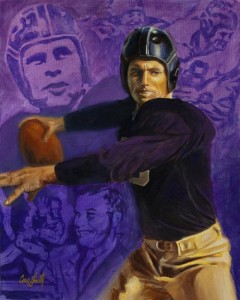
Davey O'Brien was the first Heisman Trophy winner to play in the NFL, but he left after two years to join the FBI.
Military duty and World War II influenced the NFL careers of a number of Heisman winners from the 1930s and 1940s.
Nile Kinnick, the 1939 Heisman Trophy winner from the University of Iowa, chose to attend law school rather than immediately join the NFL. He eventually joined the U.S. Navy and was killed during a training exercise.
Tom Harmon, the 1940 winner, and Bruce Smith, the 1941 selection, both served in the military during the war and did not join the NFL until after the conclusion of the war. By the time they joined the NFL, both were several years removed from their college glory and neither achieved the stardom they seemed destined for following their college careers.
The 1942 Heisman winner, Frank Sinkwich from the University of Georgia, was named the NFL Most Valuable Player in 1944. However, he joined the Air Force and was injured while playing football for their service team. He played briefly in the NFL in 1946 and 1947, but never regained his previous form.
Angelo Bertelli, the 1943 winner from Notre Dame, and Les Horvath, the 1944 winner from Ohio State, also joined the military immediately after their college careers and then had limited NFL careers.
Glenn Davis (1946 – Army), Johnny Lujack (1947 – Notre Dame) and Leon Hart (1949 – Notre Dame) each earned All-Pro honors once in the NFL, but none enjoyed sustained periods of success.
The first Heisman Trophy winner to enjoy a sustained career of NFL stardom was 1948 winner Doak Walker from Southern Methodist University. Walker played only six NFL seasons for the Detroit Lions, but he was a five-time Pro Bowl pick and a four-time first-team All-Pro. He helped lead the Lions to two NFL Championships and was inducted into the Pro Football Hall of Fame in 1986.
The early 1950s saw a number of Heisman winners who either completely spurned the NFL or played only briefly in the league due either to military service or career ending injuries.
Two Heisman winners who did have some NFL success were 1954 winner Alan Ameche from Wisconsin and 1956 honoree Paul Hornung from Notre Dame.
Ameche scored the game-winning touchdown in the 1958 NFL Championship Game for the Baltimore Colts and was a four-time Pro Bowl selection during his six NFL seasons.
After struggling early in his pro career as a quarterback, Paul Hornung became a Hall of Famer for the Green Bay Packers as a multi-purpose halfback. He was part of four NFL Championship teams and joined Walker as a member of the 1986 Hall of Fame induction class.
1959 Heisman winner Billy Cannon was part of a bidding war for his services between the NFL and the upstart AFL with the fledgling league eventually earning his services for the Houston Oilers. He helped lead the Oilers to consecutive AFL Championships and spent 11 productive seasons in the AFL.
The 1960s seemed to be filled with Heisman winners who never lived up to their potential at the professional level.
Ernie Davis, the 1961 winner, was the first pick in the NFL, but never played in the league after being diagnosed with leukemia.
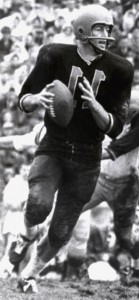
1962 Heisman winner Terry Baker from Oregon State is considered by many to be the first of the modern era Heisman "busts."
Many consider 1962 Heisman winner Terry Baker from Oregon State to be the first of the modern era Heisman “busts.” Baker played three seasons undistinguished seasons for the Los Angeles Rams after being the first pick in the 1963 NFL Draft.
1964 winner John Huarte from Notre Dame and 1967 winner Gary Beban from UCLA had very limited professional careers. Mike Garrett, the 1965 winner from USC, helped lead the Kansas City Chiefs to two Super Bowls while 1966 winner Steve Spurrier from Florida, spent a decade primarily as a backup quarterback in the NFL.
The two winners from the 1960s who enjoyed the greatest professional success were 1963 winner Roger Staubach from the Naval Academy and 1968 winner O.J. Simpson from USC. The pair ranked among the best players in the NFL in the 1970s and in 1985 became the first Heisman Trophy winners to be inducted into the Pro Football Hall of Fame.
After a series of Heisman winners who had only limited NFL success, the award started to turn around its negative NFL history in the late 1970s with a series of future superstars.
From 1976 through 1983 the award was won by eight straight running backs that all posted at least one 1,000-yard season in the NFL.
Tony Dorsett (1976 – Pittsburgh), Earl Campbell (1977 – Texas) and Marcus Allen (1981 – USC) all eventually earned busts in the Pro Football Hall of Fame. George Rogers (1980 – South Carolina), Billy Sims (1978 – Oklahoma), Herschel Walker (1982 – Georgia) and Mike Rozier (1983 – Nebraska) all enjoyed solid NFL careers.
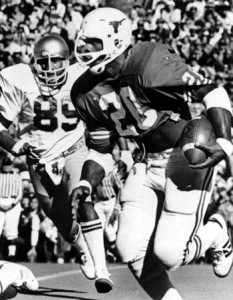
After winning the 1977 Heisman Trophy for Texas, Earl Campbell became a Hall of Fame running back for the Houston Oilers.
It looked as if you would be able to call 1979 winner Charles White from USC a “bust” after drug problems derailed his promising career with the Cleveland Browns. However, he rebounded to lead the NFL in rushing in 1987.
Beginning with Boston College’s Doug Flutie in 1984, the next five years produced Heisman winners who all had solid or spectacular professional careers. Bo Jackson (1985 – Auburn) was off to a becoming a Hall of Fame athlete in two sports before an injury during the 1990 NFL playoffs derailed his career.
If there were a Hall of Fame that considered a player’s body of work regardless of the professional league, Flutie would be enshrined. He was a solid player in the USFL, Canadian Football League and NFL.
Vinny Testaverde (1986 – Miami) and Tim Brown (1987 – Notre Dame) each enjoyed long and successful NFL careers. The 1988 Heisman winner, Barry Sanders from Oklahoma State, went on to be one of the best running backs in NFL history and is the most recent Heisman winner to be selected for the Pro Football Hall of Fame.
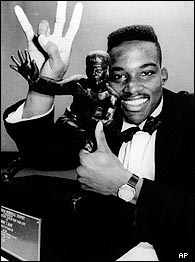
1989 Heisman winner Andre Ware may be one of the biggest busts in Heisman history. He was the seventh pick in the 1990 NFL Draft by the Detroit Lions.
Beginning with the selection of Andre Ware from Houston in 1989, the Heisman Trophy went through a stretch where the winners suddenly became annual NFL “busts.”
Of the eight Heisman winners between 1989 and 1996, the only player clearly removed from the “bust” category is 1995 winner Eddie George from Ohio State as he gained more than 10,000 yards during his NFL career.
For one shining year with the Green Bay Packers in 1996, Desmond Howard, the 1991 winner from Michigan, was an NFL star and winner of MVP honors at Super Bowl XXXI. However, that season was preceded by four awful NFL seasons for the fourth pick in the 1991 draft.
Other Heisman winners with forgettable NFL careers from that era include Ty Detmer (1990 – BYU), Gino Torretta (1992 – Miami), Rashaan Salaam (1994 – Colorado) and Danny Wuerffel (1996 – Florida). Charlie Ward, the 1993 winner from Florida State, opted for a career in the NBA rather than in the NFL.
Since 1997, only three of the 10 Heisman winners who have gone on to professional football have enjoyed solid careers, though none are likely destined for the Hall of Fame.
The possible exception is 1997 winner Charles Woodson from Michigan, who is a five-time Pro Bowl selection and enjoying one of his finest seasons in 2009. Ricky Williams (1998 – Texas) and Carson Palmer (2002 – USC) have shown glimpses of brilliance in their NFL careers.
Ron Dayne (1999 – Wisconsin), Chris Weinke (2000 – Florida State), Eric Couch (2001 – Nebraska) and Jason White (2003 – Oklahoma) all had almost no success in the NFL. The jury is still out on 2004 winner Matt Leinart and 2005 selection Reggie Bush, but so far neither has lived up to their college hype.
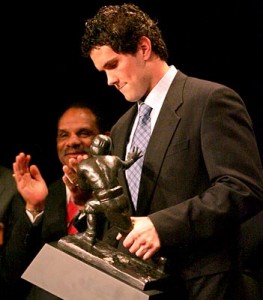
The jury is still out on whether 2004 Heisman winner Matt Leinart can be a successful pro player.
Troy Smith, the 2006 winner from Ohio State, is an NFL backup while the last two selections, Tim Tebow and Sam Bradford, have yet to enter the NFL.
What is apparent by a review of the winners and their future NFL draft status and level of success is that the Heisman Trophy is clearly an award based as much on team success than on level of individual talent and professional potential.
To win a Heisman Trophy, a player must typically be playing on a talented team that is at-least in contention for a national title.
Since Bo Jackson and Vinny Testaverde were back-to-back first picks in the NFL Draft in 1985 and 1986, Carson Palmer is the only Heisman winner to be the first selection in the NFL Draft.
However, 11 Heisman winners during that period either won a national championship or were in the national title game during the season in which they won the award.
Regardless of who wins the Heisman this weekend, you are likely looking at a similar situation in the 2010 Draft as the first pick will most likely not be one of the five players attending the festivities in New York City.
The Heisman Trophy is a wonderful and prestigious award, but it has never been, and likely never will be, a barometer for forecasting NFL success.
Instead, it guarantees for one lucky individual that no matter what happens in the NFL, they will always have a really cool paperweight to show off at dinner parties.









